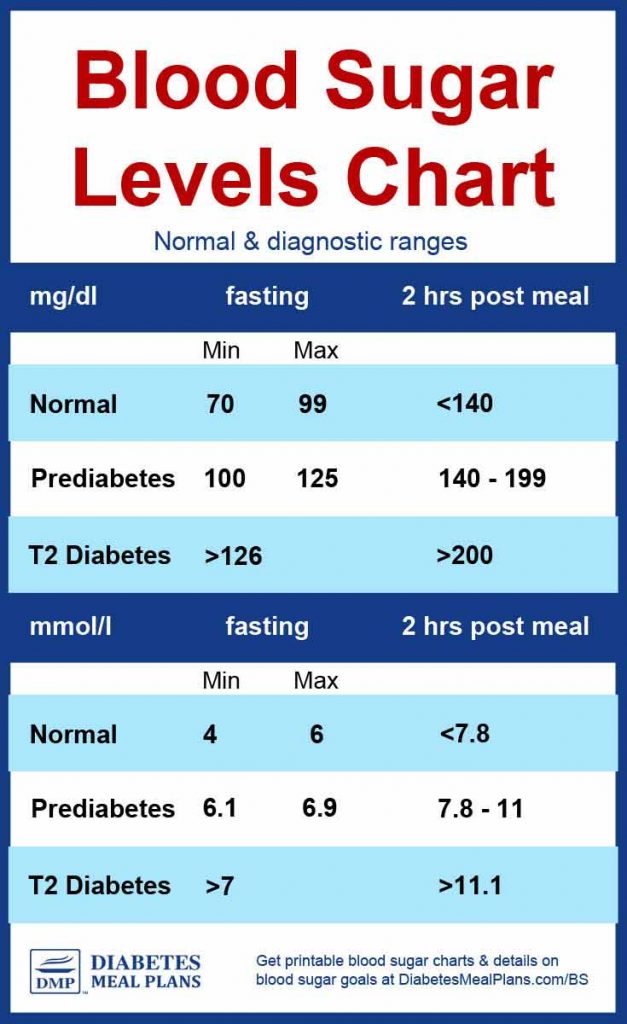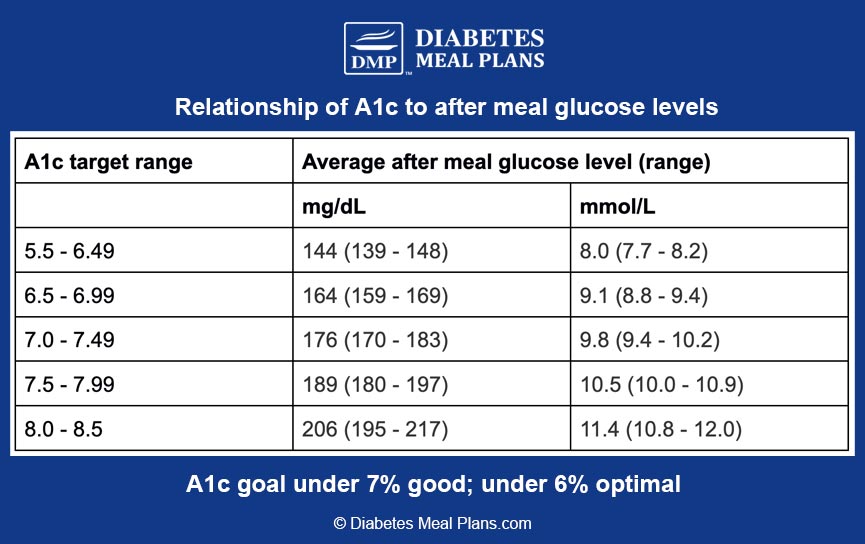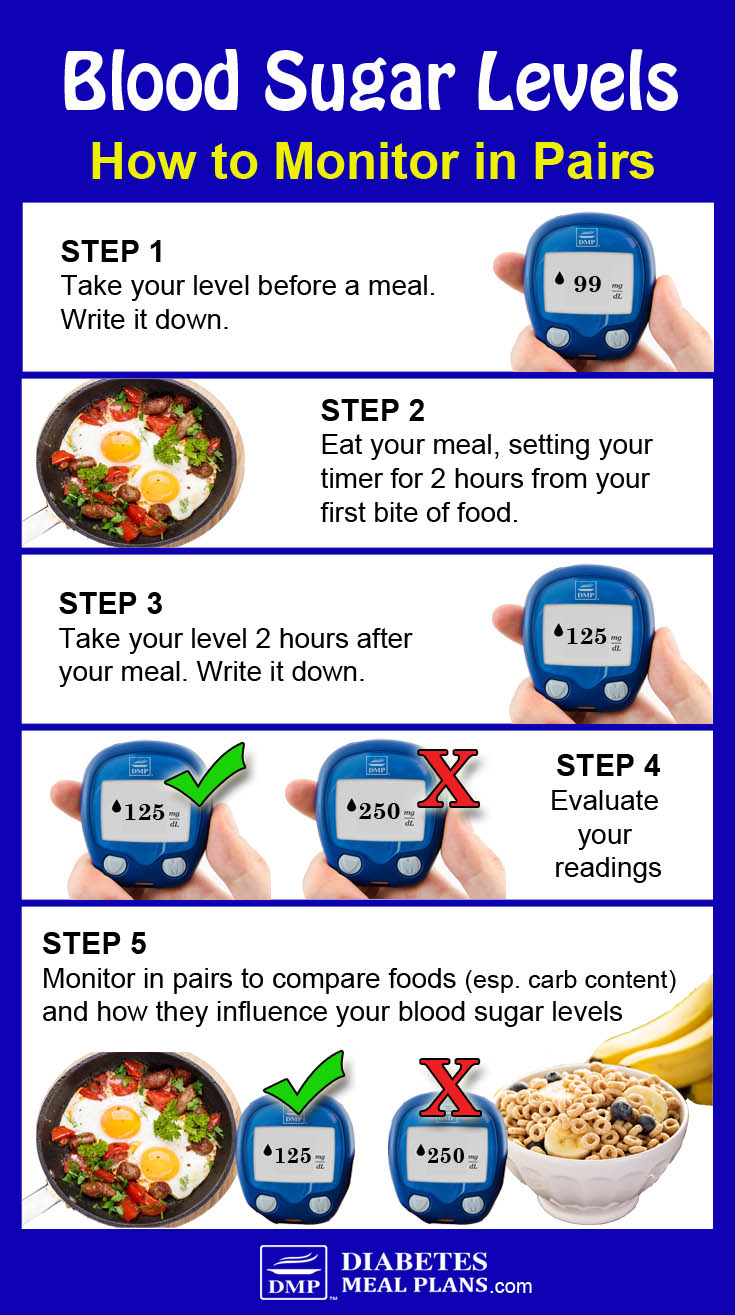It’s critical to understand the importance of blood sugar levels and their impact on your health. So here you’ll find a comprehensive guide, which includes our podcast about normal blood sugar levels and goals for type 2 diabetes and prediabetes, grab a free downloadable printable diabetes blood sugar levels chart, and find many common questions that get asked about blood sugar levels.
LISTEN TO THE PODCAST
PODCAST CHAPTERS
2:28 Blood sugar across the globe
4:15 Normal blood sugar levels
6:48 HbA1c defined and normal levels
9:31 A1c vs blood sugar
11:10 Goal levels for blood sugar and A1c
15:38 One key tip for better results
17:06 The benefits of glucose monitoring
The Importance of Good Blood Sugar Levels
Before sharing the diabetes blood sugar levels chart, we want to OVER EMPHASIZE the importance of you gaining the best control of your blood sugar levels as you possibly can. Just taking medication and doing nothing else is really not enough.
You see, people are often not fully informed about why it is so crucial to do, because if you already have a diabetes diagnosis, then you are already at high risk for heart disease and other vascular problems. Even during your pre-diabetic period, there is a lot of damage that is already done to the vascular system. This occurs due to the higher-than-normal blood sugar, that’s what causes the damage.
Regardless of whether your diagnosis is type 2 diabetes or prediabetes, you want to prevent any of the nasty complications by gaining good control over your levels.
Truly, ask anyone having to live with diabetes complications and they’ll tell you it’s the pits!
You DO NOT want it to happen to you if you can avoid it.
While medications may be needed, just taking medication alone and doing nothing is really not enough! Medication can be helpful and sometimes necessary, medication has a limited effect on lowering A1c. And if you need to take more and more medication, your diabetes is getting worse, not better.
If you empower yourself with the right nutrition and lifestyle and put scientifically proven strategies into practice, then you can eliminate or minimize medications, and prevent your health from declining. In many cases, people are even putting their diabetes into full remission – meaning their body is functioning as normal – it is possible, in many.

Leisa lowered blood sugar from 300s to normal in just 30 days!
“Not only are my readings now within normal range, I’m also down over 20 pounds and feeling so much better. Thank you.”
Now that you understand just how important this is, let’s get down to blood sugar numbers and target ranges. And at the bottom of this page, you can download printable blood sugar levels charts and daily logs.
Blood Sugar/Blood Glucose = Same/Same
You might see some charts or read some articles that say ‘blood sugar chart’ and others that say ‘blood glucose levels chart.’
Just in case you are confused, these both mean the same thing. The words ‘sugar’ and ‘glucose’ are often used interchangeably.
Let’s Crunch Some Numbers
Below we give these numbers in a written, chart, and visual format because it will make sense to you depending how you read it.
Depending where you live in the world, numbers can vary slightly. And your numbers will either be mg/dl or mmol/l. You’ll find the numbers for both of these readings below.
Normal Blood Sugar Levels
Fasting glucose – 70-99 mg/dl or 4-6 mmol/l (Note: there is some debate about the normal range in mmol/l, ranging from 5.5 to 6 mmol/l)
2 hours post meal glucose – Less than 140 mg/dl or less than 7.8 mmol/l
Pre-diabetes diagnostic ranges – also called impaired fasting glucose or impaired glucose tolerance
Fasting glucose – 100-125 mg/dl or 6.1-6.9 mmol/l
2 hours post meal glucose level – 140-199 mg/ dl or 7.8-11 mmol/l
Type 2 Diabetes diagnostic ranges
Fasting glucose – More than 126 mg/dl or more than 7.0 mmol/l
2 hours glucose level – More than 200 mg/dl or more than 11.1 mmol/l
Blood Sugar Levels Chart
The above chart and the one below are exactly the same, in different formats.
| Category | Fasting value | Post prandial / aka post meal | |
| Minimum | Maximum | 2 hours after meal | |
| Normal | 70 mg/dl | 99 mg/dl | Less than 140 mg/dl |
| 4 mmol/l | 6 mmol/l | Less than 7.8 mmol/l | |
| Pre-diabetes | 100 mg/dl | 125 mg/dl | 140-199 mg/dl |
| 6.1 mmol/l | 6.9 mmol/l | 7.8-11 mmol/l | |
| Diabetes | More than 126 mg/dl | More than 200 | |
| More than 7 mmol/l | More than 11.1 mmol/l |
These are the diagnostic ranges. As you can see, the “normal” range for fasting glucose is under 100 mg/dl or 6 mmol/l. Though just to note, there is some debate about the normal range in mmol/l, ranging from 5.5 to 6 mmol/l. So depending what chart you look at, you may see either of those numbers.
After a meal, the maximum reading you ideally want to see is 140 mg/dl or 7.8 mmol/l.
If you’re getting readings above this, you would be diagnosed with prediabetes or type 2 diabetes, as shown in the charts above.
Diabetes Blood Sugar Level Goals
Upon waking before breakfast (Fasting)
- 70-130 (Ideal under 110) mg/dl
- 4-7.2 (Ideal under under 6.1) mmol/l
Two hours after meals
- Under 180 (Ideal is under 140) mg/dl
- Under 10 (Ideal is under 7.8) mmol/l
Bedtime
- 90-150 mg/dl
- 5-8.3 mmol/l
The above levels, for people diagnosed with type 2 diabetes, are the general goals set by the American Diabetes Association and the American Association of Clinical Endocrinologists.
As suggested earlier, there is some variation in the blood sugar levels goals set by different organizations. And additionally, your physician or healthcare team may set your goals at a more stringent level.
For instance, fasting levels:
- Between 70-100 mg/dL or 4-5.6 mmol/l (optimal)
- 70-110 mg/dL or 4-6 mmol/l (still good control)
- 70-130 mg/dL or 4-7.2 mmol/l (more liberal, but realistic for many)
Once you have a type 2 diabetes diagnosis, the overall goals you should aim for is to get your blood sugar levels as close to “normal” “optimal” levels as you possibly can.
BUT, as suggested above, often goals are set with higher targets initially. For instance, if you have a high reading of 250 or 300 (13 or 17), your physician or health practitioner may recommend 200 (11.1) be an initial goal, then 180 (10), before gradually working toward 140 (7.8) and lower.
The reason this is often recommended is you can experience symptoms of hypoglycemia (low blood sugar) if you bring your levels down very quickly. So working toward tighter and tighter control does take some time.
You should work with your healthcare team on this. But overall the most optimal targets to work toward are a fasting glucose under 100 mg/dl or 6 mmol/l. And an after-meal reading below 140 or 7.8.
The Visual Version

Please pin, tweet or share this chart to help others – thanks!
Commonly Asked Questions About Blood Sugar Levels
What is the difference between blood sugar and A1c?
Blood sugar is a daily reading while A1c is a blood test that measures your average blood sugar from the previous 3 month period.
You can read more about the difference between the two over here.
Will weight loss help with my diabetes management?
Yes, by default weight loss helps because it reduces inflammation in your body and improves insulin sensitivity and overall metabolic function.
I’ve been prescribed Metformin, will that help with my blood glucose levels?
Yes, Metformin is one of the most commonly prescribed diabetes medications worldwide. It belongs to a class of medications known as “Biguanides,” which lower blood glucose by decreasing the amount of sugar put out by the liver. And it is one of the medications that does not increase weight gain.
We have detailed information about Metformin here.
Why does high blood sugar cause complications like neuropathy?
The body is designed to have a blood sugar level within a certain range, with a maximum of 140 (7.8) after meals. Levels above normal for extended periods promote inflammation in the blood vessels throughout the body, along with damage to cells – simply because the body isn’t designed to operate with levels above normal.
Diabetic neuropathy is damage to the nerve vessels resulting from chronically high blood sugar – meaning long-term, not a few high readings now and then. Other types of diabetes complications (nephropathy, retinopathy, etc) are also caused by the same factors.
What type of diet helps to lower blood sugar levels?
The T2Diet can help you get amazing results in as little as 16 weeks!

The T2Diet Program is a one of the most effective ways to improve blood sugar, A1c, weight, cholesterol and other factors.
The T2Diet helps you discover an eating plan that’s natural and sustainable for you by including the right type of carbohydrates in the right amounts at the right time, and through eating lots of other delicious foods that help to improve your overall metabolism.
Is there a different blood sugar levels chart by age?
No. The human body was designed to have blood sugar levels within a ‘normal’ range, regardless of your age.
However, different blood sugar level goals are set for each individual person, particularly children and the elderly.
The diabetes organization in my country lists different levels, why are these different?
It can make it confusing when different organizations list different values. And unfortunately, there is no one recognized value at this point, although there should be.
Here are the organization listings for some parts of the globe:
American Diabetes Association
List the normal range between 70-99 mg/dl (3.9-5.6 mmol/l).
They suggest blood glucose goals for people with type 2 diabetes are:
- 80-130 mg/dl before meals (4.4-7.2 mg/dl)
- Less than 180 mg/dl after meals (10 mmol/l)
Diabetes Australia
List the normal range between 4.0-7.8 mmol/l.
They suggest blood glucose goals for people with type 2 diabetes are:
- 6-8 mmol/l before meals (108-144 mg/dl)
- 6-10 mmol after meals / 108-180 mg/dl
Diabetes UK
List the normal range between 4-6 mmol/l (72-108 mg/dl) when fasting. And up to 7.8 mmol/l (140 mg/dl) 2 hours after eating.
They suggest blood glucose goals for people with type 2 diabetes are:
- 4-7 mmol/l before meals (72-126 mg/dl)
- Under 8.5 mmol/l after meals (153 mg/dl)
Diabetes Canada
Like Diabetes UK, they suggest blood glucose goals for people with type 2 diabetes are 4-7 mmol/l before meals (72-126 mg/dl).
5-10 mmol/l after meals (90-180 mg/dl), or if A1c goals are not being met, it should be reduced to 5-8 mmol/l (90-144 mg/dl).
Hopefully we will see organizations worldwide list the same glucose readings in future so there is not such a confusion.
Is there a relationship between blood sugar numbers and A1c?
Yes, especially your after-meal (postprandial) blood sugar level. As you can see in the chart below, if your blood sugar is up at 180 (10.0) your A1c is going to be around 7.5-7.99.

If you focus on an after-meal level lower than 140 (7.8) you will be able to achieve a normal A1c levels.
Can these charts be used as a pre diabetes blood sugar levels chart?
Yes. The charts contain the numbers for prediabetes as well. And you can use the charts to track your food intake and daily numbers, along with exercise or other notes you want to include.
Is daily blood glucose monitoring recommended?
If you have type 2 diabetes or prediabetes, daily self-monitoring using a blood glucose meter (which involves a simple finger-prick test), can be a great way to understand what is happening in your body so you can bring your levels under control.
How often should I take a blood sugar sample?
There is wide variability on how often to monitor, depending on the state of your diabetes and treatment. But, most people monitor 1-2 times daily – fasting (first thing in the morning) and 2 hours after the biggest meal. For your after-meal (postprandial) blood sample, time from your first bite of food.
If you’re newly diagnosed or trying to gain better control, it can be helpful to monitor more frequently so you can assess your progress and work on changing diet and lifestyle habits to support your goals.
One thing that is helpful with mealtimes is “monitoring in pairs.” To monitor in pairs you check your levels before, then 2 hours after a meal. It’s a great way to get an indication of the effect of foods and the amount of carbs you’re consuming. If you log your numbers and your daily food intake and lifestyle habits, you will soon see patterns emerging and then you can make the necessary adjustments to your dietary routine.

Well there you have it. Hope you find this information helpful and if you do please pin it and share it around to help others. Thanks!
While you’re here, grab a printable copy of the blood sugar charts – just enter your email below and we’ll send it to your inbox.
References
American Diabetes Association. (2017). Standards of Medical Care in Clinical Practice 2017.
American Association of Clinical Endocrinologists. Type 2 diabetes glucose management goals.
Diabetes.org. (2017). Glucose calculator. https://professional.diabetes.org/glucose_calc
Diabetes.org. (2017). Checking blood glucose.
Diabetes.co.uk. (2017). Prediabetes,
Diabetes.co.uk. (2017). Blood sugar converter. https://www.diabetes.co.uk/pre-diabetes.html
Diabetes.co.uk. (2017). Postprandial glucose test. https://www.diabetes.co.uk/diabetes_care/postprandial-plasma-glucose-test.html
Diabetesaustralia.com.au. (2017). Prediabetes.
Diabetesaustralia.com.au. (2017). Blood glucose monitoring.
Diabetes.co.uk. (2017). Blood sugar level ranges.
The royal australian college of general practitioners. (2017). HbA1c and monitoring glycemia. https://www.diabetes.co.uk/diabetes_care/blood-sugar-level-ranges.html
Diabetes.org. (2017). Diagnosis. https://diabetes.org/about-diabetes/diagnosis
Diabetes.ca. (2017). Managing your blood sugars. https://www.diabetes.ca/en-CA/resources/tools---resources/managing-your-blood-sugar

how is it that my levels befroe eating when i was fasting was 128
and after eating it was 101 …
Hi Skyler, this is called the Dawn Phenomenon where morning/fasting blood sugar is high. Find more info about high morning levels here.
I have diabetes from post Whipple Surgery, where should my numbers be?
Hi John, The ideal targets for blood glucose levels are relevant for all people, eg: below 130 fasting (ideal under 100), under 140mg/dl after meals, A1c under 7% or under 6 if achievable. Sometimes, in the case of whipple surgery your healthcare team may advise otherwise depending on your unique situation.
WHAT IS THE IDEAL READING FOR A 81 YEAR OLD PERSON TYPE 2 WEIGHT 170 I GET DIFFERENT READINGS
HIGH IS 160
Hi Joyce, ideal fasting is under 100, but up to 130 is okay; and ideal after meals is under 140.